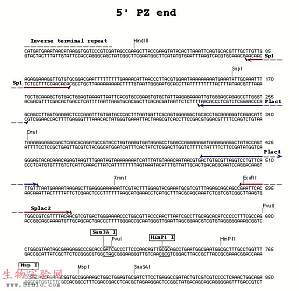I. Quick Fly Genomic DNA Prep Standard fly mini prep (30 flies) resuspended in 150 ul TE 1) Collect 30 anesthetized flies in eppendorf tube and freeze at -80°. 2) Grind flies in 200 µl Buffer A with disposable tissue grinder (Kontes). 3) Add an additional 200 µl Buffer A and continue grinding until only cuticles re ...
PCR 在突变基因检测中应用 基因突变(gene mutation)是遗传病和肿瘤发生的根本原因,检测与遗传病及恶性肿瘤发生有关的突变基因(mutant gene)是分子生物学,医学遗传学及肿瘤学研究的热点,它对阐明遗传病和肿瘤发生的分子生物学基础及其诊断和早期诊断具有重要的意义。分子生物学技术的发展,尤其是PCR技术的出现及近年来以PCR技术为基础,结合传统技术的突变基因分析方法为人们提供了许多快速、简便、准确的基因分析途 ...
Single Cell PCR(Protocol provided by Carolyn Troeger) Cell picking c Axiovert 100/Zeiss, extended glass capillary/Drummond, Broomall and a micromanipulator/Zeiss Transfer cell into PCR tube containing 5 µl of 400 ng/µl Proteinase K/17 µM SDS (50 µl stock = 1 µl 20 mg/ml Prot K + 49 µl 0.005% SDS) Overlay c ...
Basic Principles (see also Page 01) The requirement of an optimal PCR reaction is to amplify a specific locus without any unspecific by-products. Therefore, annealing needs to take place at a sufficiently high temperature to allow only the perfect DNA-DNA matches to occur in the reaction. For any g ...
For the successful PCR or multiplex PCR amplification of many loci (especially products between 100-1000 bp) raising the buffer concentration to 1.4x-2x (or only the KCl concentration to about 70-100mM) dramatically improves the efficiency of the reaction. In fact the effect of the KCl conc ...
Absolute value of primer concentration in multiplex PCR. The amount of DNA primer(s) available during the PCR reaction influences the results. Primer concentration taken in a common PCR reaction (for example when amplifying a single locus) is about 100-500 nM each primer. (Primers can be purc ...
Standard PCR reaction mix Consider the standard PCR reaction mix (25 µL reaction) below. All reactions are run for 30 cycles.Table 1. PCR reaction componentsCOMPONENT VOLUME FINAL CONCENTRATION 1. autoclaved ultra-filtered water (pH 7.0)20.7µL-2. 10x PCR Buffeundefined2.5µL1x3. dNTPs mix (25 mM ...
Single locus PCR. First step in designing a multiplex PCR is choosing the primer pairs which can be combined. One important requirement is to find a PCR program allowing optimal amplification of all loci when taken individually (Fig. 9). This is achieved by adjusting the annealing and extension ti ...
Isolate Total RNA using Qiagen midi kit (Cat#75142) (see manufacturer's protocol) or by Trizol (Gibco BRL Cat# 15596-026) extraction (see manufacturer's protocol) or by PaxGene extraction (Pax tubes Cat# 762115, Pax Blood Extraction kit Cat# 762134) (see manufacturer's protocol). Resus ...
This procedure is a "hot start" PCR cycle for use with large primers. PCR mass-produces DNA contained in the source plasmid between the two primer-binding sequences, eventually producing linear DNA starting with Primer 1, continuing with the source sequence, and ending with the complement ...
Expand is a mixture of Taq and Pwo DNA polymerases (Boehringer). Pwo polymerase has 3' to 5' exo proofreading activity. If amplifying a 1 Kb fragment for 20 cycles, expect ~8% of the products will have at least one mutation. See Boehringer data sheet for more details on error rate. Mix in an 0.2 ml thin wall microfuge t ...
This method is more reliable than the old method of adding yeast directly to PCR tubes. No more than 1 microliter of the crude DNA should be added to the 50 microliter PCR reaction because the SDS in the DNA prep can inhibit the PCR reaction. Note: These elongation times and annealing temperatures work well for ...
The amplification of DNA fragments using the polymerase chain reaction (33) is performed in either the Perkin-Elmer Cetus DNA Thermal Cycler or the Perkin-Elmer Cetus Cycler 9600, by adding the following reagents to either a 0.2 ml thin-walled tube or a 1.5 ml tube, respectively: a small amount of the t ...
This procedure will work for both yeast and E. coli:Take a small colony and suspend it in 5ul of H2O in a PCR tube. Heat for 5 min at 95¡C and then spin the condensation down in a microfuge. Set up the PCR reaction as follows:5ul H2O + cells 5ul 5uM primer2 5ul 10XTaq Buffer 5ul 2mM dNTPs 0.5ul 10 mg/ml acetylated BSA 1ul Taq DNA poly ...
质粒快速鉴定 试剂:Protoplasting buffer: 30mM Tris-HCl, pH8.0 0.33ml/1.0M 5mM EDTA 0.1ml/0.5M 50mM NaCl 0.1ml/5.0M 20% Sucrose 5ml/40% 50µg/ml RNAseI 50ul/10mg/ml 50µg/ml lysozyme 50ul/10mg/ml补水至10ml,-20℃分装保存。Lysis buffer:89mM Tris-HCl, pH8.089mM boric acid 2ml of 5×TBE2.5mM EDTA2% SDS 2ml of ...
BEST" PCR conditions for amplifying DNA from plasmids 25 ng linear template (~6.5 kb)50 pmol each primer100 pmol each dNTP1X Promega Taq buffer (no Mg++)1.5 mM MgCl21 U Taq DNA polymerase in 50 ul final92°C / 2' 92°C / 30" 50°C or 55°C (depends on Tm of oligos) /30" 72°C / about 2' per kb Go to 2, 15 times 70°C/ 8' 4°C...hold. Takes about 2 ho ...
ReagentsAgarose, UltrapureGibco, BRL, Cat. no. 15510-02710X Buffer, andPerkin Elmer (Part no. N808-0010)Template DNAUse 50-100 ng for each reactionEthidium BromideResearch Genetics, Cat. no. 750007Loading buffer, 5XQuality Biological, Cat. no. 51-026-030MgCl2, 25 mMPerk ...
TAIL is a series of reactions that are intended to map where a T-DNA (transfer DNA) has inserted within the genome. The main components of the 3 reactions are the AD (Arbitrary Degenerate) primers, border primers, and DNA from the T-DNA lines that are to be mapped. AD primers are degenerate primers that anneal ...
Efficient Long PCR results from the use of two polymerases: a non-proofreading polymerase is the main polymerase in the reaction, and a proofreading polymerase (3' to 5' exo) is present at a lower concentration. Following the results of Cheng et al. (1) we have had success using Tth (ABI/Perkin-Elmer) as ...
The identification of novel members of gene families by PCR using degenerate primers has been considered more of an art than a science, so much so that the methods books I've come across have been too timid to discuss the considerations that go into the design of this experiment, much less give a protocol for ...






